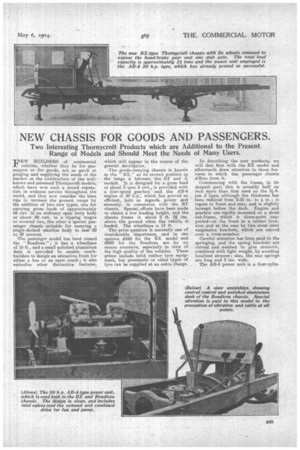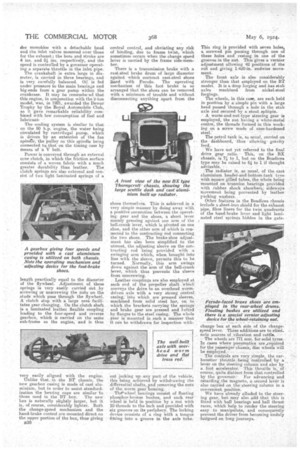NEW CHASSIS FOR GOODS AND PASSENGERS.
Page 15

Page 16

If you've noticed an error in this article please click here to report it so we can fix it.
Two Interesting Thornycroft Products which are Additional to the Present Range of Models and Should Meet the Needs of Many Users.
F' ' BUILDERS of commercial vehicles whether they be for passengers or for goods, are as quick at gauging and supplying the needs of the market as the constructors of the well-known and esteemed Thornycraft models, which have won such a sound reputation in arduous service throughout the world, and they now consider the time ripe to increase the present range by the addition of two new types, one for carrying gross loads of approximately 55 cwt. in an ordinary open lorry body or about 50 cwt. in a tipping wagon or covered van, the other a special passenger chassia suitable for carrying a single-decked omnibus body to seat 29 to 30 persons.
The passenger model has been named the " Boadicea "; it has a wheelbase of 16 ft., and a small polished aluminium dash is provided to enable coachbuilders to design an attractive front for either a bus or an open coach ; it also embodies other distinctive features, which will appear in the course of the general description.
The goods-carrying chassis is known as the " BX," as its correct position in the range is between the BT and X models. It is designed for .a gross load of about 3 tons 5 cwt., is provided with a four-speed gearbox and the AB-4 engine of 30 h.p.; •which has proved so efficient, both as regards power and economy,' in connection with the BT chassis. Special efforts have been made to obtain a low loading height, and the chassis frame is about 2 ft. E4 ins. above the ground when the vehicle is loaded. The wheelbase is 13 ft.
The Price question is naturally one of considerable importance, and in our opinion 2665 for the BX model and 2695for the Boadicea are by no means excessive, especially in view of the high quality of the vehicles. These prices include solid rubber tyre equipment, but pneumatic or other types of tyre can be supplied at an extra charge. In describing the new products, we will deal first with the BX model and afterwards draw attention to those features in which the passenger chassis differs from it.
Commencing with the frame, in its deepest part this is actually half an inch more than that used on the 3A-4ton J type, although this thickness has been reduced from 9-32 in. to A in, ; it tapers to front and rear, and is slightly inswept before the dash, Engine and gearbox are -rigidly mounted on a stout sub-frame, which is three-point supported—at the front in a rubber trunnion and at the rear by two stout steel suspension brackets, which are curved over a cross-member.
Careful attention has been paid to the springing, and the spring brackets are curved and webbed to give strenath, combined with light weight, by avoiding localized stresses; also, the rear springs are long and 3 ins. wide. • The AB-4 power unit is a four-cylin nor monobloc with a detachable head and the inlet valves mounted over those for the exhaust.; the bore and stroke are 4 ins. and 51 ins, respectively, and the speed is controlled by a governor operating a separate throttle in the inlet pipe.
The crankshaft is extra large in diameter, is carried in three bearings, and is very carefully balanced. 011 is fed under pressure to the main bearings end big-ends from a gear pump within the crankcase. It May be remembeeed that this engine, in conjunction with the 2-ton model, was, in 1921, awarded the Dewar Trophy by the Royal Automobile Club, as it -gave remarkable reliability combined with low consumption of fuel and lubricant.
Thecooling system is similar to that on the 50 b.p. engine, the water being circulated iv eentrifugal pump, which is driven by an extension of the fan spindle; the pulley on this spindle being connected toi that on the timing• case by means of -a V belt.
Power is conveyed through' an external ccne clutch, in which the friction surface consists of a woven fabric with a much greater durability than leather. The clutch springs are also external and eon-' slat of two light laminated springs of a length practically equal to the diameter of the flywheel. Adjustment of these springs is very easily carried Out by screwing or unscrewing the nuts on the studs Which pass through the flywheel. clutch stop with si large area facilitates gear changing. On the clutch shaft. is a laminated leather.. flexible coupling leading to the four-speed and reverse gearbox, which is carried on the same sub-frame as the engine, and is thus very easily aligned with the engine.
Unlike that, in the BT chassis, the new gearbox casing is made of cast aluminium, but in order to assist standardization the bearing caps are similar To those used in the BT box. The new box is naturally slightly larger, bet it is, of course, considerably lighter. Roth the change-sansed mechanism and the hand-brake control are mounted direct, on the upper portion of the box, thusgiving
B30 central control, and obviating:any risk of binding, due to frame twist, which sometimes occurs when the change speed leter is carried by the frame 'side-member.
There is a transmission brake with a castesteel brake drumof large diameter against which contract cast-steel shoes lined with Ferodo. The operating mechanism Of this foot brake is so arranged that the shoes can be removed with a minimum of trouble and without disconnecting anything apart from the A front view of .the new BX type Thornycroft' chassis, showing the large scuttle dash and cast ahitninium built:up radiator.
•
shoes themselves. This is achieved in a. very simple manner by doing away with a positive connection between the operatinggear and the shoes, a short lever merely .pressing 'against one .arm of the bell-crank lever, which is pivoted on one shoe, and the other arm of Which is connected to the contracting rod connecting. the two shoes. The brake-shoe adjustment has also been simplified to the utmost, the adjusting sleeve on the contracting rod being provided with a swinging arm which, when brought into line with the sleeve, permits this to be turned. Normally, this arm swings down against the arm of the bell-drank lever, which thus prevents the sleeve from unscrewing.
Leather Couplings are also employed at each end of the Propeller shaft which' conveys the drive to an overhead wormdriven axle with a very' strong central, casing, into which are pressed sleeves, machined from solid steel bar, on to which the brackets carrying the springs' and brake gear are pressed and 'bolted by flanges to the steel casing. The whole gear is mounted in such a manner that it can be withdrawn for inspection with out jacking up any part of the vehicle, this being achieved by withdrawing the differential shafts, and removing the nuts of the worm gear housing.
Thsrwheel.bearings consist of floating phosphor-bronze bushes, and each rear wheel is held in position by a writ with 10-threads to the uich and provided with six grooves on its periphery. The hacking device -consists of a ring with a tongue --fitting into -a groove in -the aide tube.
This ring is _provided with seven holes, a 'screwed pm passing through one of these holes and resting in one of the grooves in the nut. This gives a vernier adjustment allowing 42 positions of the mit and giving 1-420-in. endwise movement.
The front axle is also considerably stronger than that employed on the B'r model. It is a drop forging and ha a stub axles machined from nickel-steel forgings.
The wheels, in this case, are each held in position by a' simplepin with a large head passed through a hole in the stub axle and secured by a stout splitpin.
A worm-and-nut-type steering gear is employed, the Out having a white-metal centre, the threads formed in this working on a screw made of case-hardened steel.' . . The petrel tank is, as usual, carried on the dashboard, -thus 'alloiving gravity We have not yet referred to the final drive gear ratio.' This, on the BX chassis, is 7A to 1, but on the Boadicea type may be raleed to 6A to 1 if thought advisable. • . .
:The radiator is, as usual, of the cast aluminium header-and-bottom-tank type • with square gilled tubes, the whole being moianted on trunnion bearings_ provided with rubber shock' abeorbers;• sidewaYs movement being prevented by leather picking washerS. . Other features in the Boadicea chassis . include a sheet-iron shield for the exhaust pipe, fibre liners for the twin quadrants of the hand-brake !ever and light laminated steel sminese hidden in the gate.
change box at each side of the change. speed lever. These additions are to elimi. nate sorirdes of vibration and rattle. The wheels are 771 mm. for solid tyres.-: In cases where pneumatics are .required for the passenger chassis; disc wheels Will be employed, •. • • ••
The controls are very simple, the car-hnretter throttle being controlled by a lever on the steering column' and also by a foot accelerator. This throttle is, Of • course, quite distinct from that controlled by the governor. For advancing and retarding:the magneto, a• second lever is also carried on the steering column ina convenient position.
We have already alluded to the steer-. log gear, but may also add that this is fitted with ball bearings and ball thrust races, which help to render the steering easy to manipulate, and consequently prevent the driver from becoming unduly fatigued on long journeys.


































